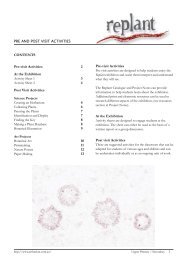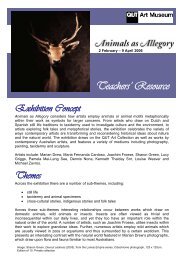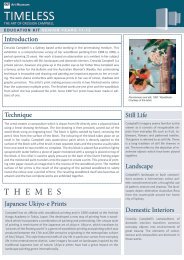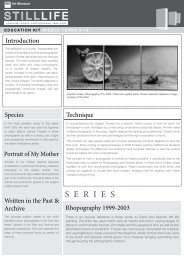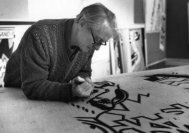Artifice - QUT Art Museum
Artifice - QUT Art Museum
Artifice - QUT Art Museum
You also want an ePaper? Increase the reach of your titles
YUMPU automatically turns print PDFs into web optimized ePapers that Google loves.
<strong><strong>Art</strong>ifice</strong>:<br />
Recent Queensland Photography<br />
Teachers’ Notes<br />
“Any ‘dodge, trick, and conjuration’ of any kind is open to the photographer’s use so that it<br />
belongs to his art, and is not false to nature…. It is his imperative duty to avoid the mean,<br />
the bare and the ugly, and to aim to elevate his subject, to avoid awkward forms, and to<br />
correct [the] unpicturesque.” i<br />
- Henry Peach Robinson, 1869<br />
Introduction<br />
Since the inception of the photographic image, the notion of ‘the truth of photography’ has been<br />
associated with the medium’s ability to capture ‘real life’. Of course, the photograph is always<br />
mediated: individual elements are selectively included or excluded, poses controlled, scenarios<br />
staged. Further editing can occur in the darkroom. With digital advances in photography, entire<br />
images can be created beyond the realm of the everyday.<br />
All of the artists in <strong><strong>Art</strong>ifice</strong> draw on pictographic histories, be they based within the fields of<br />
photography, painting, advertising, popular culture or indeed a combination of the aforementioned.<br />
The intellectual impetus of the artworks lifts the images above the realm of the snapshot or<br />
photograph-as-window-on-the-world, for ‘… contemporary art photography, while acknowledging<br />
its own history, draws on a range of traditions, both artistic and vernacular, and reconfigures them<br />
rather than simply emulating them.’ ii<br />
Areas of Interest for Students:<br />
• Constructing reality through manipulation and composition<br />
• Digital and analogue processes<br />
• Identity<br />
• Photography as a contemporary art medium<br />
• Staging
2<br />
Camilla Birkeland<br />
Key points:<br />
• Constructed space/photographic set<br />
• Scale<br />
• The relationship between humanity and the<br />
natural world<br />
Camilla Birkeland’s Standing witness series explores<br />
constructed space and scale. Her photographs have<br />
associations with 19th Century Romantic landscape<br />
painting and the ruins of grand architecture. Birkeland<br />
states “photography, painting, sculpture, installation art<br />
and science fiction converge in this work”. Birkeland plays with scale to produce images of<br />
apparently cavernous ruins that are in reality small, domestic spaces. The natural landscape itself<br />
does not appear in Birkeland’s photographs, yet her works suggest the sublime magnificence of<br />
natural terrain such as the fjords of her native Norway. The tiny ‘everyman’ that is dwarfed by his<br />
surroundings is a powerful metaphor for humanity and the insignificance of the individual.<br />
Birkeland’s almost monochromatic images in the Standing witness series are dominated by the<br />
geometric surroundings that simultaneously possess an organic feel. Set in a disused backyard<br />
incinerator (itself a now-defunct structure, with its primary function outlawed through current<br />
pollution laws), the photographs hark back to a bygone era. The play on physical space and scale<br />
transforms the ‘everyman’ into a figure caught in a performative moment, suggesting a narrative in<br />
the manner of a film-still but without the clues of what will next occur or what has previously<br />
passed. Like a film set, it is unclear whether the surroundings are real or artificial – the surrounding<br />
‘oversized’ blocks could easily be made of polystyrene.<br />
In her latest body of work, Staged, Birkeland removed the everyman figure and switched to<br />
constructed interiors for backdrops. Birkeland ‘explores the representation of three-dimensional<br />
space in photographic media’ iii . Ordinary<br />
objects assume a strange, otherworldly<br />
aura. The viewer cannot be certain what<br />
Birkeland’s objects are, and their scale<br />
remains indeterminate. She<br />
contemplates one’s insignificance within<br />
the infinite mystery of the cosmos and<br />
brings into question the futility of human<br />
endeavours in attempting to control and<br />
dominate the planet on which we exist.
3<br />
Mari Hirata<br />
Key points:<br />
• repetition<br />
• identity<br />
• symbolism<br />
• cultural heritage/cultural traditions<br />
Gold Coast artist Mari Hirata was born in Japan to parents of mixed heritage and lived there until<br />
her family migrated to Australia in 1991. Her own life experiences are reflected in the crosscultural<br />
references in her work. Hirata’s most recent series of work, Sacred ties, is a personal<br />
narrative that pays homage to her late mother and considers the enduring mother-daughter<br />
relationship over generations. The series marks various stages in a woman’s life. To reach, to hold<br />
features numerous white shoes (an icon from Hirata’s earlier work) which symbolise entrenched<br />
expectations and ideals of women. Amid this wave of white shoes is a solitary red shoe of<br />
individualism, gently held in two hands. iv The gentleness conveyed by the unidentified woman’s<br />
gesture suggests both a cradling/nurturing of the shoe and an offering.<br />
A Japanese sensibility pervades the series through Hirata’s strategic arrangements and her iconic<br />
use of red, white and black. Her works also possess many of the formal qualities of Australian<br />
photographers such as Wolfgang Sievers (born 1913) and Olive Cotton (1911-2003). The strong<br />
geometric elements of Hirata’s To reach, to hold echo the modernist style of Cotton’s famous<br />
photograph Tea cup ballet (c.1935).
4<br />
Joachim Froese<br />
Key points:<br />
• exploration<br />
• colonisation<br />
• migration<br />
• landscape<br />
• the ‘photographic essay’<br />
• display<br />
When producing Contactproofs Joachim Froese<br />
was interested in the history of Australia’s<br />
colonisation from the beginning of European<br />
contact with Tasmania. For Froese, this body of<br />
work looks critically at his own migration process from Germany. Froese’s use of photography to<br />
create objective accounts of his adopted home, Tasmania at the time, revealed to the artist the<br />
viewpoint of a displaced European.<br />
Tasmania was discovered by the Dutch navigator Abel Tasman on 24 November 1642 and Froese<br />
became particularly interested in the means of navigation that Tasman used. Due to the<br />
navigational equipment available at the time, Tasman consistently recorded his position<br />
inaccurately as he could only measure latitude and had to use guesswork to estimate longitude. The<br />
series focuses on the inherent inaccuracies of European global exploration, citing Tasman’s<br />
attempts to geographically pinpoint coastal sites around Tasmania without the ability to accurately<br />
measure longitude. Froese photographed the actual locations matching Tasman’s recorded (but<br />
incorrect) geographic markers, with each site’s latitude and longitude appearing as text beneath the<br />
images.<br />
Froese documents the physical geographical locations that match Tasman’s recorded positions. The<br />
haphazard nature of the early explorer’s documentation of his ‘first contact’ with the island is<br />
echoed in the jarred, uneven presentation which includes irregular framing of the negative and the<br />
inclusion of film arrows and the spaces in between individual negatives. The series aligns with<br />
segments of an oversized photographic contact proof, in turn playing on the concept of a physical<br />
evidence of contact. The gold framing also suggests an historical document rather than<br />
contemporary artistic practice.<br />
That Tasman’s suggested locations existed either well inland or out to sea indicates that history is<br />
often a point-of-view. Froese dissects and reassembles, implying history can be (and ought to be)<br />
scrutinised and questioned.
5<br />
Pete Johnson<br />
Key points:<br />
• social documentary photography<br />
• urban environment<br />
• hard-edge abstraction and colour field painting<br />
• art historical references (such as Barnett Newman and Jeffrey Smart)<br />
• composition<br />
The traditions of social documentary photography are the entry point into the work of Pete<br />
Johnson, who ponders the nature of the constructed environment in contemporary urban areas.<br />
While his style is not new, Johnson proposes that familiar, everyday spaces are as valid as ‘the<br />
Other’ as subjects for contemporary photographic investigation. In doing so he ‘reflect(s) our own<br />
culture back to us and avoid(s) any fascination with the exotic.’ v<br />
Johnson’s work also mirrors his personal concerns with environmental degradation, and<br />
overzealous building programs which promote development at the cost of nature. Johnson’s<br />
compositions highlight a dominance of the geometric shape of contemporary industrial architecture<br />
and design over organic form. This is further reinforced through his choice of locations, which often<br />
encompass blocks of monotone colour. Such formal qualities make reference to geometric and hardedge<br />
abstraction painting. Photographs such as Village - Kippa-Ring 2006 also allude to the op-art<br />
movement, where the variations in our automatic responses to colour produce illusions of shifting<br />
depths within the colour field. Such references are clear and deliberate. Johnson openly<br />
acknowledges his subjectivity in interpreting these landscapes in such a manner, underscoring the<br />
influence that art and visual culture has on his work. vi<br />
Johnson’s work Helmet – Clontarf 2004 (left)<br />
captures an industrial building feature that has a<br />
strong connection to the infamous Australian bush<br />
ranger Ned Kelly. A similar motif was used by Sydney<br />
Nolan in his Ned Kelly series.<br />
The distinct shadows and stark light in Johnson’s<br />
works suggest the paintings of Jeffrey Smart. Where<br />
Smart constructs urban environments on the canvas,<br />
Johnson captures these moments from real life<br />
around suburban South-East Queensland.
Johnson’s concern for geometric forms<br />
and solid blocks of colour references the<br />
work of many iconic abstract painters<br />
from the 20 th Century such as Kenneth<br />
Noland and Barnett Newman.<br />
6
7<br />
Maurice Ortega<br />
Key points:<br />
• identity and social stereotypes<br />
• narrative<br />
• constructed scenes/staging<br />
• art historical references<br />
In his Billboards series Maurice Ortega investigates concepts of masculinity and, to a lesser<br />
extent, race. His constructed images, informed by the language of advertising, see himself cast as<br />
the central protagonist in various scenes from country doctor to Christ. He plays the<br />
archetypal/stereotypical hero in a variety of roles which each, in their own manner, brings into<br />
question the concept of masculinity. David Broker summarised Ortega’s work as follows:<br />
Maurice Ortega mocks the idea of ‘social acceptability’ by acting out and exaggerating<br />
conventional male role models that would have us see him as a doctor, a lover or a man in<br />
suit. In referencing photographers such as Helmut Newton and Frank Hurley, his works<br />
subvert traditional models by revealing role plays that expose the callous, the colonial, the<br />
carnal. vii<br />
A key work in the series is based on The incredulity of Saint Thomas (c.1600, oil on canvas) by<br />
Caravaggio (Italian, 1571-1610). Ortega’s mise en scene is ‘the Gabba’, home of the Brisbane Lions<br />
AFL team. It was photographed in 2004 when the Lions’ popularity was soaring following three<br />
back-to-back premierships in 2001, 2002 and 2003. The ‘Lions Den’ is a formidable arena, thus an<br />
ideal setting for the visual reinterpretation of a religious tale. Ortega replicates Caravaggio’s<br />
composition of characters. In place of robes he uses hotel towels, yet stills follows traditional colour<br />
schemata with himself (Christ) in white.
9<br />
Marian Drew<br />
Key points:<br />
• photography influenced by painting<br />
• symbolism<br />
• studio set-up<br />
• environmental concerns<br />
Marian Drew reflects upon the traditions of<br />
European still-lifes to ponder the fate of Australian<br />
native animals that have met their demise as roadkill,<br />
or a similar end. Her sumptuous studio images<br />
reconsider and recontextualise vanitas imagery, while<br />
maintaining the grandiose overtones of their source<br />
material. As Russell Storer recently wrote:<br />
[European] still life painting not only depicted the fruits of wealth and the breadth of<br />
ownership, but was also a desirable commodity in itself. Often gathering together the<br />
products of the owner’s estates with the exotic spoils of colonialism, ripe for the taking, the<br />
still life represented human control over the natural world, breaking the bonds of space and<br />
time. The four corners of the earth come together in this singular, domestic space: numerous<br />
species of flowers bloom simultaneously, every fruit is in season, diverse objects gain a<br />
pictorial equivalence and everything has its price. viii<br />
Objects in Drew’s work are visual acknowledgments of the art history to which they refer, but the<br />
metonymic memento mori icons are replaced with the reality of death in the form of carcasses of<br />
native wildlife that have been killed as a result of human activities. The animals are presented as<br />
peaceful, serene, posed models (and no they are not just sleeping, as some younger viewers have<br />
asked). In the Australiana series, Drew also considers the history of wildlife photography. She<br />
explains, ‘[The work] presents wildlife that becomes dislocated from the idealised view of animals in<br />
their natural habitat. The long lens of the ‘wildlife photographer’ is replaced by the close up lens,<br />
painted light and the table top.’ ix
11<br />
<strong><strong>Art</strong>ifice</strong>:<br />
Recent Queensland Photography<br />
<strong>QUT</strong> <strong>Art</strong> <strong>Museum</strong> 17 August – 29 October 2006<br />
2 George St Brisbane QLD 4000 (next to City Botanic Gardens)<br />
Tues-Fri 10am – 5pm, Wed until 8pm, Sat-Sun 12-4pm | www.artmuseum.qut.com<br />
Original text by Gordon Craig, Curator (Collections and Exhibitions) <strong>QUT</strong> <strong>Art</strong> <strong>Museum</strong><br />
Adaptation of and additional text by Simone Jones, Curator (Public Programs) <strong>QUT</strong> <strong>Art</strong> <strong>Museum</strong><br />
Designed by Simone Jones<br />
All images reproduced with permission of the artists where applicable<br />
Image captions<br />
Page 1<br />
Mari Hirata, details of To reach, to hold (from the series Sacred ties), 2006. Type C photograph, 100 x 100cm. Courtesy of the artist and<br />
Schubert Contemporary, Gold Coast<br />
Page 2<br />
Top: Camilla Birkeland, Circle (From the series Staged), 2006. Pigment ink on cotton rag, 105 x 90.5cm. Courtesy of the artist.<br />
Bottom: Camilla Birkeland, Standing witness no. 13, 2005. Pigment ink on cotton rag, 90 x 110cm. Courtesy of the artist.<br />
Page 3<br />
Left: Mari Hirata, To reach, to hold (from the series Sacred ties), 2006. Type C photograph, 100 x 100cm. Courtesy of the artist and<br />
Schubert Contemporary, Gold Coast<br />
Right: Mari Hirata, The Pregnant Bride (from the series Sacred ties), 2006. Type C photograph, 100 x 100cm. Courtesy of the artist and<br />
Schubert Contemporary, Gold Coast.<br />
Page 4<br />
Top: Joachim Froese, Contactproofs no.2, 1995. Silver gelatin photograph, 40 x 50cm. Courtesy of the artist and Jan Manton <strong>Art</strong>,<br />
Brisbane.<br />
Bottom: Joachim Froese, Contactproofs, 1995. Thirteen silver gelatin photographs, each 40 x 50cm. Courtesy of the artist and Jan<br />
Manton <strong>Art</strong>, Brisbane.<br />
Page 5<br />
Pete Johnson, Helmet - Clontarf 2004. Inkjet print, 75 x 50cm. Courtesy of the artist.<br />
Page 6<br />
Top: Pete Johnson, Tradelink - Clontarf 2006. Inkjet print, 75 x 50cm. Courtesy of the artist.<br />
Bottom: Pete Johnson, Village - Kippa-Ring 2006. Inkjet print, 75 x 50cm. Courtesy of the artist.<br />
Page 7<br />
Maurice Ortega, From the Billboards series, 2000. Lambda print, 125 x 188cm. Courtesy of the artist. (‘The rockstar’)<br />
Page 8<br />
Top: Caravaggio, The incredulity of Saint Thomas, c.1600. Oil on canvas.<br />
Bottom: Maurice Ortega, From the Billboards series, 2004. Lambda print, 125 x 188cm. Courtesy of the artist. (‘Doubting Thomas’)<br />
Page 9<br />
Top: Abraham Mignon, Still life with bowl of fruit, oysters and a porcelain bowl, c. 1660-79. Oil on canvas, 66 x 53cm. Rijksmuseum,<br />
Amsterdam.<br />
Bottom: Marian Drew, Tasmanian swamp hen with apples, 2005. Giclée print, 90 x 113cm. Purchased 2006 through the Betty Quelhurst<br />
Fund. <strong>QUT</strong> <strong>Art</strong> Collection.<br />
Page 10<br />
Top: Willem Claesz Heda, Breakfast with a Lobster, 1648. Oil on canvas. Hermitage <strong>Museum</strong>, Russia.<br />
Bottom: Willem Claesz Heda, Still Life with Pie, and Silver Jug, 1658. Oil on canvas.<br />
References<br />
i Henry Peach Robinson quoted in Baatz, Willfried. Photography: A Concise History, Laurence King, London,<br />
1999: p.46<br />
ii Cotton, Charlotte. The Photograph as Contemporary <strong>Art</strong>, Thames and Hudson, London, 2004: p.15<br />
iii Birkeland, Camilla. Unpublished artist’s statement, 2006: n.p.<br />
iv Hirata, Mari. Unpublished artist’s statement, 2006: n.p.<br />
v Johnson, Pete. Subtopia 1, Master of Visual <strong>Art</strong>s exegesis, Queensland College of <strong>Art</strong>, Griffith University,<br />
Brisbane, 2004: n.p.<br />
vi Ibid.<br />
vii Broker, David. ‘Mike Gray, Greg Leong, Maurice Ortega: A Crisis of Masculinity’, Photofile no. 72, Spring<br />
2004: p.48<br />
viii<br />
Storer, Russell. Marian Drew: Photographs + Video Work, Queensland Centre for Photography, Brisbane<br />
2006: p.76<br />
ix Drew, Marian. <strong>Art</strong>ist’s statement, Dianne Tanzer Gallery, Melbourne, 2005: n.p.




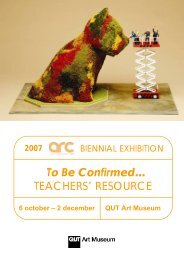

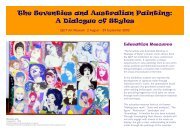
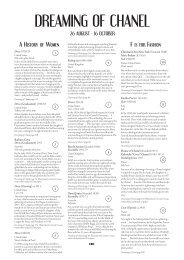
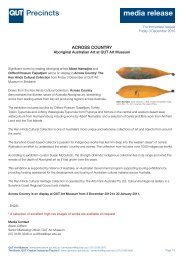
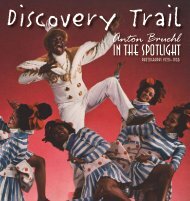

![Senior Years (10-12) [pdf - 4.5 MB] - QUT Art Museum](https://img.yumpu.com/38225334/1/184x260/senior-years-10-12-pdf-45-mb-qut-art-museum.jpg?quality=85)
